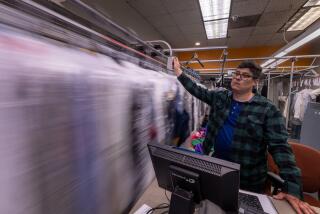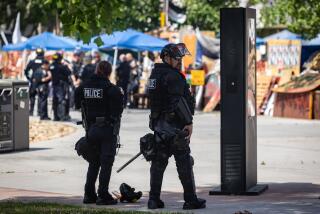Occupy protesters shift focus to downtown L.A. business group
- Share via
Nearly eight months after police cleared hundreds of Occupy L.A. protesters from their sprawling camp on the City Hall lawn, officials are poised to reopen the park Thursday.
But while elected leaders have taken pains to keep the group from returning, recently strengthening rules against camping in parks, activists insist there is nothing to worry about. They say they’ve moved on.
Since early June, protesters have been training their cross-hairs on the Central City Assn., a downtown business group that represents local shop owners but also large corporations and banks. The association donates to local politicians and lobbies on major City Hall issues, from utility rate increases to the recent “responsible banking” ordinance supported by Occupy protesters.
“It is the bridge of money into politics,” said Ryan Rice, a 27-year-old protester who joined Occupy in October. “There is no better target here in L.A.”
PHOTOS: Occupy L.A., Central City Assn.
Activists have confronted the association at every turn, picketing outside board meetings, infiltrating monthly luncheons and infuriating its director, Carol Schatz. She calls them “young street people who are much more anarchistic” than the original protesters at City Hall, and says they have brought crime and vandalism to a community working to restore life to buildings that have long stood vacant.
Tensions came to a head last week at the monthly downtown Art Walk, when 17 people were arrested after police moved in on a group of protesters chalking the sidewalks. But ground zero of the standoff can be found each night outside the association’s headquarters on Wilshire Boulevard — where scores of protesters have been raising their familiar tents.
With the exception of some new faces, and the fact that the tents must come down every morning at dawn, the new encampment feels a lot like the old one. There are hand-made posters with political messages, and occasional puffs of marijuana smoke. There is music, sometimes blasting from a boom box, other times echoing from guitars and bucket drums. And there is conversation. Constantly.
On a recent night, half a dozen young people sat on the ground talking, a few sipping coffee and smoking cigarettes.
A stranger approached. “What’s this all about?” he ventured.
Jessica Rey, a 23-year-old in a knit beanie, gestured to the office building.
“This building right here is home to the” Central City Assn., she said. “They take money from all these bankers and developers to basically buy out the City Council.”
The man nodded.
“They represent Wells Fargo,” she said.
“And Verizon,” another person added.
“And AEG,” another said. “And Wal-Mart.”
Critics have complained that the local contingent of the original Occupy Wall Street movement lacks focus and chose the wrong symbol in L.A. City Hall. They say it has a rag-tag constituency undeserving of media attention.
Sixteen-year-old protester Isaac Badger said he thinks the group is now getting it right by targeting the Central City Assn. and the downtown business district, where the U.S. Bank building and other skyscrapers light up the skyline. “We’re in the belly of the beast,” he said.
The next day, Schatz sat in her bright corner office. Crews had already washed off the protesters’ chalk on the sidewalk outside from the night before, a now-daily ritual that is just one example, she said, of how Occupy is sucking resources from the downtown community.
Protesters have caused thousands of dollars of damage to Pershing Square, where they hold their regular general assembly meetings, according to a member of the park advisory board. John Edwards, the organizer of a weekly farmers market at the park, said he is considering pulling out because of disruptions by loitering protesters.
Schatz called protesters’ tactics of blocking cars from entering her building’s parking garage “absolutely frightening.”
“We are so angry,” she said.
Schatz is known for aggressively and often effectively pushing projects for such favored allies as Anschutz Entertainment Group. She proudly takes credit for helping spur the wave of new development that has come to downtown over the last decade and a half, including AEG’s Staples Center and L.A. Live.
When she speaks about the role of businesses as job creators, she can sound like Republican presidential candidate Mitt Romney. But Schatz, 64, describes herself as a moderate Democrat. Her mother was a member of the Communist Party.
She says protesters are wrong if they think the business community has outsize influence in L.A., where labor unions also contribute to politicians and hold considerable sway.
She has a theory about the protest on her doorstep. She thinks the Occupy demonstration has been co-opted by the Los Angeles Community Action Network, a group that has for years fought her association’s policies and push for more policing downtown.
Becky Dennison, one of LACAN’s directors, denies that. So do Occupy activists, who say they work with many groups. Earlier this month, they joined a labor-led march against a planned Wal-Mart grocery store in Chinatown, as well as a demonstration with antiwar activists in support of Bradley Manning, who is accused of giving the WikiLeaks website classified field reports from Iraq and Afghanistan.
As was the case when the protest was centered at City Hall, not everyone connected with the movement is particularly political. Outside of the Central City Assn.’s headquarters the other evening, a 19-year-old who was staying there admitted that he didn’t know why they were there. Sean Gregg, who was homeless on the streets of Philadelphia when the Occupy movement began, says he’s spent the last eight months traveling between protests around the country.
Documentary filmmaker Sam Slovick, who was shooting at the camp that night, said the media have sensationalized the movement’s “outliers,” the hangers-on and the rabble rousers.
He pointed to Rey and her friends, who were still huddled in a circle, talking. They, he said, were one of the core groups of committed activists.
Strangers when Occupy began, they have bonded through months of late nights and frequent face-offs with police. Rey has been arrested three times, most recently for chalking the sidewalk outside a Central City Assn. luncheon.
A recent college graduate, she said her experiences have radicalized her and furthered her commitment to her protest. “There’s no going back,” she said.
More to Read
Sign up for Essential California
The most important California stories and recommendations in your inbox every morning.
You may occasionally receive promotional content from the Los Angeles Times.











